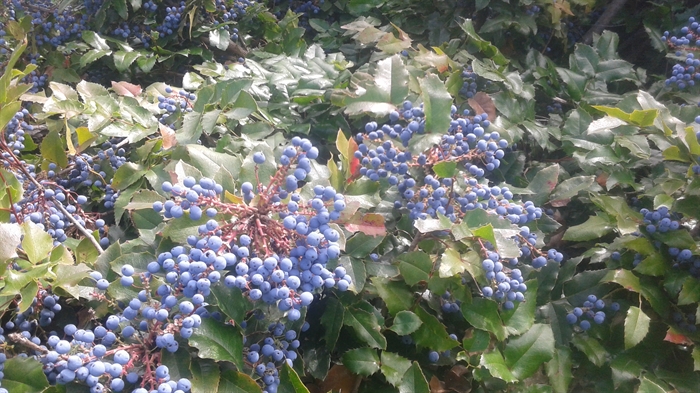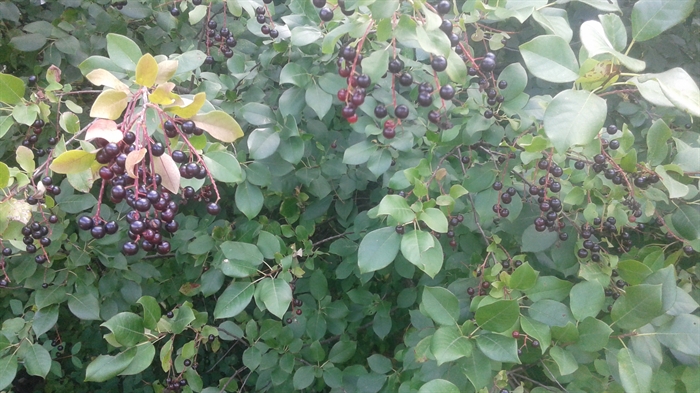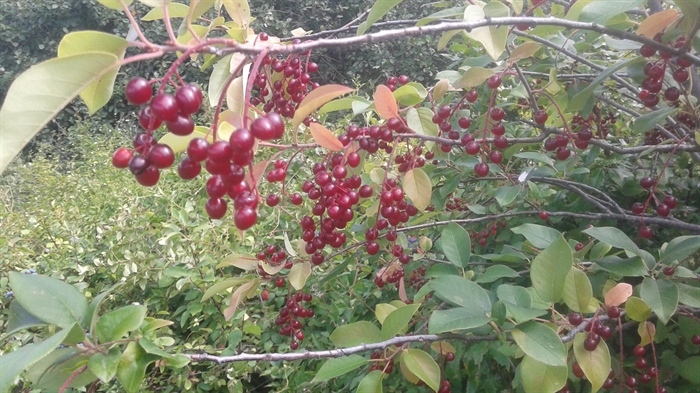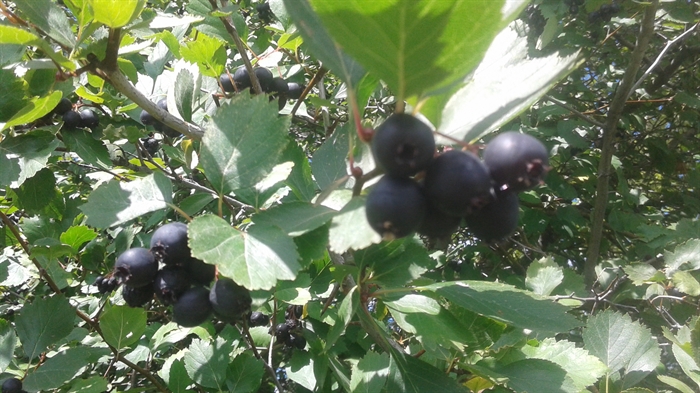
Oregon grape grows on a shrub that resembles holly with sharp-looking edges to the leaves. It is a common native plant in our fields and forests but can also be found in gardens.
(SCOTT MORAN / iNFOnews.ca)
July 20, 2016 - 12:00 PM
OPINION
Chokecherries, Oregon grape, and black hawthorn berries are all ready to harvest right now in the Southern Interior of B.C. All three of these local wild fruits can be cooked down for use in different recipes. These shrubby plants can be found up and down the countryside of the Okanagan. They can also be found in the heart of our cities.
The edge of fields and parks, and especially all the vacant investment properties sitting around Kelowna and other cities in the valley are a treasure-trove of wild edibles. More than any other place, wild edibles like to grow on recently disturbed ground. It almost seems as though they have adapted to follow around human activity. One example would be the dandelion growing alongside a forest trail. The dandelion will only be at the edge of the trail, and will not grow in the forest. They cling to the disturbed area to try and fix the soil and break it up with its roots. They are there to make corrections. It is worth noting they also correct us when ingested.
Our edible berry plants will thrive on the edges of properties and have temporary life, providing us with food before they get cut down and built over. These bushes also have a tendency to conceal homeless people in the Kelowna area, so they are cut down to take away their shelter and hiding place. There is a steady cycle of disappearance and reappearance of plants in the city that enjoy disturbed ground. It is best to stay aware and take what is available whenever possible. Next week they might not be there.

Chokecherries dangle from their branches in like small bunches of grapes. The chokecherries in this image dark purple.
(SCOTT MORAN / iNFOnews.ca)
After picking and selling these wild berries to chefs for a few years, I have learned a few picking tips as well as creative and tasty uses for these berries.
Black hawthorn berries grow on a tall and spiky bush or tree, depending on size. They resemble blueberries and have a soft pulp on the inside when ripe (as well as a few very hard seeds). They will taste a bit like plums. Cook down a pot full of these berries with sugar or honey and strain to make delicious syrup. This is one of the best flavours with ice cream or yogurt, and perfect for pancakes or crepes. The black hawthorn berries has a variety of medicinal benefits and is loaded with nutrients. You can eat your medicine.
Oregon grape grows on a shrub that resembles holly with sharp-looking edges to the leaves. It is a common native plant in our fields and forests but can also be found in gardens. Thanks to the folks using native plants in their landscaping. It is hard to tell when the clusters of small light-blue berries are ripe. The easiest way to tell is when the berries fall off the stem easily. They have wine-coloured juice and an intensely sour flavour. I think the flavour resembles sour grapes. Cook down the grapes with heaps of sugar and make a jelly for a plate of cheese and cured meats.

Chokecherries dangle from their branches in like small bunches of grapes. They are found in two colours. The one pictured is red and resembles sour cherries.
(SCOTT MORAN / iNFOnews.ca)
Chokecherries dangle from their branches in like small bunches of grapes. They are found in two colours. One is red resembling sour cherries and the other a dark purple, similar to lapin cherries. The dark chokecherries will be red when they are unripe so be careful. Chokecherries will fall off the stem when they are ready. Try to find juicy ones in a partially sheltered area with lots of plant life to hold water. Cook down unsweetened chokecherries with a bit of liquid, add salt and spices, and use as a barbeque sauce.
All of these wild edibles are nutrient-rich and loaded with medicinal benefits. The experience of getting out into your local area and collecting can be just as beneficial. Getting hands-on with our local plant life in such a tasty way can help increase our appreciation and knowledge of our surroundings, helping us to understand our place in our environment and how we can interact with the land. This can only be a good thing.

Black hawthorn berries grow on a tall and spiky bush or tree, depending on size. They resemble blueberries and have a soft pulp on the inside when ripe (as well as a few very hard seeds).
(SCOTT MORAN / iNFOnews.ca)
We welcome your comments and opinions on our stories but play nice. We won't censor or delete comments unless they contain off-topic statements or links, unnecessary vulgarity, false facts, spam or obviously fake profiles. If you have any concerns about what you see in comments, email the editor in the link above.
News from © iNFOnews, 2016